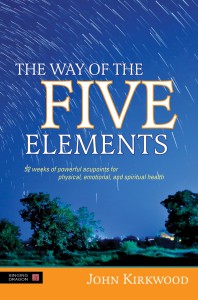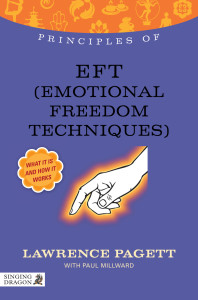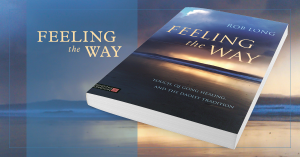 Following the recent release of Feeling the Way, author Rob Long participated in a Q&A with his colleague Shelagh Brady to discuss his new book and what ‘healing’ means for him.
Following the recent release of Feeling the Way, author Rob Long participated in a Q&A with his colleague Shelagh Brady to discuss his new book and what ‘healing’ means for him.
Spiritual Development
Feeling the Way: What Does it Mean to Heal Someone?
 In this blog by Rob Long, author of Feeling the Way, Long examines what healing means and how it applies to our lives.
In this blog by Rob Long, author of Feeling the Way, Long examines what healing means and how it applies to our lives.
In my new book ‘Feeling The Way’ I make the bold claim that everybody possesses what is commonly called ‘healing hands’. That means you! What appears in the book is a stripped-back, extremely practical how-to guide, based on insights from over twenty years of my own trial and error in the clinic. I have called what I do ‘Qi Sensitivity Healing’, or QHS for short, and whilst much of it is innovative, it also owes a huge debt to ancient Chinese practices, especially those of the Daoists, those progenitors of Acupuncture, herbal medicine and many other instantly recognizable modalities .
The Six Phases of Taoist Qigong Practice
#QigongFestival2016
by Camilo Sanchez, L. Ac, MOM
Traditionally, the practice of qigong comprises different phases of training based on the various stages of cultivating vital energy or qi. Schools of qigong variously mention four, five, six and even seven phases of practice. However, despite these differences, the general procedure of qigong practice remains all the same.
In the school of Taoist qigong we follow six main stages of practice. This article describes the main phases of training and the requirements for each stage of practice.
-
Unblocking Qi and Strengthening Postnatal Qi (nei yang gong)
During the first phase of qigong training the focus is on unblocking qi and conditioning the physical body by opening the joints, lengthening the tendons and connective tissues, increasing flexibility of the spine, and releasing restrictions to the flow of vital energy in order to strengthen and improve the circulation of the guardian qi (wei qi) on the surface of the body. At this stage of practice we pay attention to cultivating relaxation (song), achieving correct body posture and fulfilling the five essential requirements for aligning the body, learning the principles of proper body mechanics, improving breathing, and establishing the three external harmonies (wai san he), namely harmonizing the shoulders with the hips, the elbows with the knees, and the hands with the feet.
This phase of training involves clearing blockages of qi from the energy channels, regulating the body, and optimizing the absorption of postnatal qi derived from nutrients and breathing. It may include the practice of dynamic qigong (dong gong), breathing techniques (tu na), gymnastics (dao yin), internal martial arts, and the use of diet and medicinal herbs to strengthen the body, restore health and increase vitality. At the same time, we begin the practice of qigong stances (jing gong) and meditation so as to calm the mind, relax the nervous system and cultivate tranquility.
-
Harnessing and Generating Qi (yang qi)
In the second stage of practice we aim at gaining control of the three energies acquired after birth (hou tian qi) including the qi derived from food and breathing (acquired qi), the reproductive essence (acquired jing), and our conscious mind (acquired shen), to help replenish the procreative essence of the body (yuan jing) as the foundation for the following phases of qigong practice. Our original essence (yuan jing) has been likened to the oil that feeds the wick of a lamp. It serves as the basic energy or fuel required for the processes of internal energy transformation. Without it the wick will burn quickly and the lamp will die out. Traditionally, this stage has been called “Laying the foundation” (zhu ji).
We focus on training the breath until it is long, deep, slow, even, smooth and fine, as well as coordinating the breathing with the stances and the external movements of the body. At this stage of practice the three external harmonies should be coordinated with the three internal harmonies (nei san he) of vital energy (qi), intention (yi), and heart-spirit (xin) where the qi leads the movements of the body, the intention leads the qi, and the spirit leads the intention.
At this stage the practitioner makes use of mind focus to guide breathing to the abdominal region thus bringing more blood and nutrients into the lower dan tian and the life gate region (ming men). This process helps to strengthen the procreative essence of the body and hormonal production (jing), in this way establishing a good root or foundation (zhu ji).
Harnessing qi requires improving the absorption of qi from nutrients and breathing, opening the qi field of the body to harness qi from nature, reducing the dissipation of vital energy through the cultivation of stillness and tranquility of the mind, and preserving our sexual energy or jing. The three dan tian centers are specific locations for gathering, generating and cultivating the three internal energies of procreative essence, vital energy, and spirit.
-
Refining Essence to Vital Energy (lian jing hua qi)
After the procreative essence of the body has been restored and made complete again, it needs to be refined into original qi (yuan qi). This process of transformation is accomplished through circulating vital energy along the controlling vessel (du mai) and the function vessel (ren mai). The constant cycling of vital energy along the small heaven orbit refines essence into original qi, the same way that exciting the movement of water through the application of fire transforms liquid into steam and gas.
At this level of practice one achieves the coordination between the external movement of the body and the internal movement of qi. When practicing the various exercises the intention, the qi and the movements of the body are integrated into a unified action. At this point in the training one achieves proficiency in the practice of moving qigong (dong gong), experiences a strong current of qi, and is able to control the movement of qi inside the body.
This phase of training requires that one cultivates a clear, tranquil and natural state of mind so that the mind links with the qi and guides the flow of vital energy inside the body. This stage of qigong involves activating the small heaven orbit of qi (xiao zhou tian), circulating internal qi, and refining essence to vital energy.
-
Emergence of the Inner Elixir (jie dan)
This is the stage in which the qi acquired after birth joins and combines with the prenatal qi. The process of inner contemplation and stability of the spirit refines original qi in a higher level energy or shen with its own special functions. At this stage the practitioner aims at taming the mind and minimizing desires. One reaches a state of stillness and clarity of the spirit thus recovering the original nature of the mind.
Refining vital energy to spiritual energy is marked by the activation of the large heaven orbit (da zhou tian), also known as “The intercourse between heaven (qian) and earth (kun)”. It comprises the circulation of refined qi through the central channels in the arms, legs and trunk (zhong mai). Furthermore, opening the grand heaven orbit has the broader meaning of opening the channels and qi field of the body to the field of nature and freely interchanging energy with the primordial qi of the cosmos. At this stage of qigong cultivation all the energy channels are open and clear and vital energy flows smoothly throughout. The maturation of the large heaven orbit marks the state of fetal breathing (tai xi). This is the phase of refining vital energy (qi) to spirit (shen).
Traditionally, it is said that this phase of practice takes about ten months to complete so it is referred to as the “Ten month pass” (shi yue guan). However, this time frame should not be taken literally as the time required to go through these transformations cannot be fixed and will vary according to the individual and other factors surrounding one’s practice.
At the completion state of this phase the practitioner realizes internal light and perceives the internal organs. Also, various potential extra-sensorial abilities may become manifest according to the methods of practice and nature of the individual. At the advanced state of fetal breathing, external breathing stops through the nose, and one enters a state of profound serenity where internal breathing through the dan tian and the pores of the skin becomes activated.
-
Transition to External Elixir (wai dan)
The complete refinement of vital energy to spirit will lead to the return of spirit back to emptiness, or a virtual state. This stage marks a transition from the previous phases characterized by conscious effort (you wei) to a condition of non-interfering or non-doing (wu wei), which is a state of non-localized awareness and mindful emptiness.
When qigong practice reaches this stage, the flow of internal energy is not limited to specific channels and vital points, but it will be able to flow like running water filling the entire space of the arms, legs, and trunk, and reaching the center of the palms, bottom of the feet and crown of the head.
The practitioner is able to guide internal energy and establish a permanent line of qi between the two lao gong cavities on the palms. Over time, the sensation of external qi expands, increases, and becomes stronger. With further practice, the flow of qi to the hands and the exterior of the body will combine with the ball of qi inside the dan tian center thus uniting the internal qi with the external qi. At this stage of qigong the practitioner is able to direct and issue internal energy to the qi cavities at will for healing with qi, or self-defense usage. This stage of cultivation includes activating the large heaven orbit of qi (da zhou tian), refining vital energy (qi) to spiritual energy (shen), and issuing external qi.
This phase marks the completion of the immortal spirit or yang spirit (yang shen), which later will be released through the central channel of the body, also known as the fetal channel (chong ju), and out of the body from the opening at the crown of the head. The complete refinement of vital energy to spirit culminates in the formation of the great elixir (da dan). The great elixir manifests as a bundle of energy that settles in the lower dan tian and serves as the seed of the original spirit (yuan shen).
Traditionally, this stage is described by the terms “Nine years pass (jiunian guan)”, or “Nine years facing the wall” referring to the story of Bodhidharma, the first Zen (Chan) Buddhist Patriarch of China, who at this stage of cultivation sat facing the wall for nine years. In Taoist internal alchemy the number nine symbolizes a high level of completion. Thus, this state of practice indicates an advanced level of inner refinement and a return to the original state of body and spirit.
Consciousness is brought back to its pristine purity and clarity and the mind dwells on xing, or one’s original nature. The spirit abides in absolute emptiness and void. In this context emptiness doesn’t mean a state of complete void or nothingness. Rather, it is an experiential dimension devoid of any subjective impressions and dualistic concepts, also known as a virtual state because it contains the potentiality for manifesting any phenomena and it provides a gateway to transcendental reality.
-
Returning to Original Nature (yuan xing)
When the practitioner reaches this stage the “Heavenly eye” will open-up and various potential abilities of the human body will become manifest. With the opening of internal vision the practitioner will develop the special functions of qigong cultivation. The development of these potential faculties will vary in each individual depending on the nature of the practitioner, state of health, method of training, previous karma and level of cultivation, among other factors surrounding one’s practice.
Breaking from all attachments, including the attachment to emptiness itself, and shedding any subjective feeling or trace of individuality will allow consciousness to attain a state of oneness. At this point, the individual realizes complete enlightenment (yuan jue) and merges with the great Tao.
This stage highlights uniting the three original energies of jing, qi, and shen into the yang spirit (yang shen) in the head, releasing the spiritual body (yang spirit) to merge or unite with the Tao, enlightening the mind, and realizing one’s nature. This is the stage of returning shen (consciousness) to original nature or Tao, and connecting with the primary qi of the universe (xian tian zhen yi zhi qi). In this way, one can establish the root of the golden elixir (jin dan). It is from this foundation that we can cultivate Tao and approach our true nature.
The higher levels of qigong involve the cultivation of xiu lian or purification and refinement. Since there is a direct relation between the state of vital energy and the state of the mind, one can only reach up to a certain level of achievement in qigong practice without purification of the mind. Xiu lian is the practice of transforming the quality of the mind, adjusting behavior, balancing lifestyle, and cultivating one’s spiritual nature. In short, it involves the cultivation of virtue (te), character and merit (gong). Without the cultivation of character one cannot harmonize the mind and without harmonizing the mind it is not possible to cultivate our vital energy or qi.
Camilo Sanchez is the author of Daoist Meridian Yoga. For more information, click below.
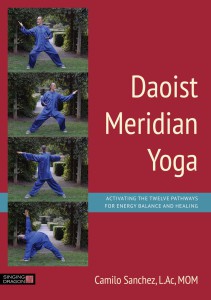
Women’s Nei Gong for Health and Transformation of Spirit
#QigongFestival2016
by Roni Edlund
The energetic make up of male and female bodies varies, hence there are different elements in Nei Gong practice that women can use to ensure a steady progression in their internal cultivation process. There are also specific energy centres, areas and Qi circulations that women benefit from spending more time cultivating than men, as well as focusing on their connection to the moon. During the first couple of years of Nei Gong practice, you can add the female specific aspects; however, it is not essential to, because the first stages are the same for both men and women.
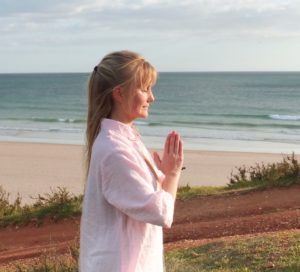
When you first start, you need to begin to re-activate the energy system towards the healthy, free flowing state you were at as a child, via an energetic field called the lower Dan Tien. You begin to bring the right focus, gravity, and energy towards this point. After some time the energy begins to flow more strongly. The beauty of this process is that once the energetic engine has restarted, you do not have to actively focus on blockages that needs to be let go of. It will start to re-open and rebalance your body, energy and mind naturally by itself; pushing through blockages of the meridians, physical tensions, emotional hurts, mental hang-ups etc. They all start to shift and free up. It is a surprisingly strong process, which is good because you can be very sure that the re-awakening of the energy system is not happening in your imagination. After you have started to activate the lower Dan Tien you will notice that Qi gong exercises become much stronger and you will begin to be able to tune into your own energy. It is very fascinating coming into contact with this dimension! If you were to practice the Qi Gong exercises in our system without first activating the lower Dan Tien, the effect would not be as strong, as you would not have started the energetic engine prior to trying to drive it, though the slow relaxing movements would still move some energy and undoubtedly be beneficial for your health.
Later on in the Nei Gong practice, women need to use some different exercises to ensure that they move on as efficiently as they can in the process. There are several women-specific exercises that work with the various energetic cycles which are important for the female body and psyche. There is a bigger emphasis on rebalancing the middle Dan Tien and consolidating the Jing storage within this region and the breasts for better emotional health and stability, and a deeper spiritual connection. This is why later on in women’s practice, there is more of an emphasis on the reverse flow of the small waterwheel, which strengthens the natural extraction of essence from the uterus and the menses towards the breasts and the chest region. You do not want to move onto this stage too early, before you have gone through the first stages of the Nei Gong process and started to let go of emotional blockages and been able to start to open the heart. If you do this too early, you would just end up adding to the emotional imbalance and distortions and hinder the process. Men benefit more from spending more time on re-balancing the physical, energetic and mental aspects connected to the lower Dan Tien.
One major difference between female and male bodies is the storage of Jing. Jing is our essence of life; the substance that is responsible for all physiological processes and development, when it runs out you die. In men Jing is stored in the lower back region of the Kidneys. Women store Jing here too, but also in the chest and the breasts. This is why women’s practice often includes exercises that work on the breasts. Doing breast Qi Gong and massage firstly moves the Qi and the blood within the region, preventing pain, stagnation and lumps building up. Secondly it stimulates the Jing and consolidates it within this region. This makes the breasts firmer, stops them from sagging and ensures less Jing leaks out with the menses. Through consolidating the Jing around the middle Dan Tien, heart and emotional center, less Qi and Jing will also be lost through emotions resulting in more Qi rising to nourish the Shen for spiritual work.
Another major aspect for women’s practice is to connect with the energy of the moon. The moon is the most Yin body in our solar system. Women vibrate at a frequency closer to Yin, compared to men who are more Yang. This means that women’s energy resonates more with the energy of the moon and therefore is more affected by it. The moon waxes and wanes on a monthly basis, just like the menstrual cycle. During the dark moon, it has reached its most Yin state; the energy in both the environment and in the central channel of our bodies descends. Another term for the central channel in Chinese medicine is the “sea of blood”. It has a strong influence on our menstrual blood and the uterus. If you are in sync with the energy of the moon, your menstruation should start when the descending of Qi reaches its strongest time. If it does not start during this period there are certain exercises you can do to influence the flow in the central channel, such as Dark Moon Qi Gong, shown in the video at the end of this article and explained in detail in the book, Daoist Nei Gong for Women: The Art of the Lotus and the Moon. Dark Moon Qi Gong should only be practiced around the dark moon. Once you manage to connect with the flow of the moon, menstruation will become regulated and the health of the uterus will increase. Its psychological aspects will also become more balanced such as a woman’s ability to express herself creatively.
For me, good and strong health is important because it means we will have a more solid base to build our spiritual work on. Health is not the end goal of women’s practices; it can go a lot further and have a deeper effect on the spirit and transform the mind. We should start to see health as a platform for spirituality rather than the end goal.
The healthier our physical body is, the easier the energy will flow in the meridians, and the more nourished the Shen becomes. This makes sure we get an easier entry point to work on the deeper aspects of Nei Gong. The deep internal work of internal alchemy (meditation) becomes much more efficient with a strong balanced mind. Doing the first stages of internal work through Nei Gong is a lot easier for most, than going directly from everyday life, where the mind is scattered on so many things, into trying to quieten the mind. It can be very tricky.
I love Nei Gong practice because you can get so much more out of life and yourself through it. Your body, mind and being begins to feel lighter and freer than you can ever remember experiencing before, you feel vibrations in your environment and inside your body, you feel your mind go through big transformational shifts, you come in contact with congenital consciousness instead of the acquired mind, you feel how things influence you and this gives you the internal tools to work with them to help balance and transform yourself. It is very interesting; there is always another subtle layer to find and experience. It adds another dimension to life and enables you to work with a lot more than just the physical world. It is fascinating!
Find out more about Daoist Nei Gong for Women by Roni Edlund and Damo Mitchell below.
Some words about Dr. Schrott’s book: ‘Marma Therapy’
by Jonathan Hinde, qualified Sukshma Marma Therapist and an Aromatherapist, based in Cambridge, UK.
There are, broadly speaking, two contrasting ways of viewing the body, and two correspondingly different approaches to healthcare: Modern western medicine has its emphasis on the purely physical; while the approach exhibited by oriental and traditional healthcare systems sees the physical symptoms as the ‘precipitated value of consciousness’ and seeks to engage with the subtle imbalances (which may be emotional, spiritual, etc) which have given rise to physical symptoms. Continue reading
Gateways to Greater Health
In The Way of the Five Elements, John Kirkwood references a category of acupoints known as entry and exit points. Here, he elaborates on these points, the timely use of which can make big differences to treatment outcomes.
Qi flows through the 12 organ meridians in a continuous circuit. It flows out of the exit point of one meridian and into the entry point of the next meridian in the Wei Qi cycle. For most of the meridians the entry point is the first point of the meridian. The exit point is either the last point or one close to the end of the meridian.
Entry-Exit Blocks
If work with a client is not holding, there may be a block to treatment and it is worth looking for a possible entry-exit block since these are the most frequently encountered blocks and the most easily treated. Acupressure is well suited to working with these blocks.
An entry-exit block arises when Qi is not flowing freely from one meridian to the next. The blockage of Qi flow between exit and entry point may be partial or complete.
Sometimes a block becomes evident early in treatment, but more commonly, the block occurs during the course of treatment and needs to be addressed in order for the treatment to proceed successfully.
Diagnosing Blocks
The most reliable way to detect blocks is on the pulse where there is a relatively full pulse on one meridian and a relatively deficient pulse on the following meridian. If the pulse is not used, signs and symptoms such as skin eruptions, swelling, pain, constriction, feelings of congestion, fullness or emptiness at the entry-exit points are all suggestive of a block.
In addition, if treatment suddenly becomes less effective or stops working altogether, an entry-exit block may be suspected. An unexpectedly strong reaction during the course of treatment can also indicate a block. This kind of block is caused when an existing block manifests itself as a result of the extra Qi that is made available.
Treating Blocks
When a block is suspected, palpation of the points can confirm the diagnosis. Holding the points, the practitioner may sense a numbness, deadness, emptiness and/or lack of movement either at the entry point, the exit point, or both.
Blocks may be bi-lateral or unilateral. To focus your intention, it is best to work on one side at a time. Begin by holding both the entry and the exit point. Stay with both if both are blocked. If only one is blocked, then hold the one blocked point.
Some points can take a long time to open, and even then reluctantly. When both practitioner and client visualise pulling Qi through, this can aid the process.
More than one treatment may by necessary to resolve a block. Even when the block appears to be resolved, it may reappear later in treatment.
Two Kinds of Blocks
Since there are 12 organ meridians, there are 12 possible blocks. Six of these flow from a meridian into its partner meridian (e.g. Gall Bladder to Liver). The other six flow from a meridian of one Element to a meridian of another Element (e.g. Triple Heater to Gall Bladder).
It is this second kind of block that I want to focus on here since it occurs more frequently, is the greater block to treatment and tends to produce the more serious symptoms.
Large Intestine to Stomach
LI 20 is slightly lateral and superior to the outside base of the nose. Qi flows to ST 1 which lies below the pupil at the orbital ridge. Signs and symptoms can include spots or rashes at LI 20, nasal congestion, sinusitis, difficulty smelling, spots or rashes below the eye, eye spasms, pain or congestion at the eye.
Spleen to Heart
This is one of the more common entry-exit blocks. SP 21 lies on the side of the body, below the armpit in the 7th intercostal space and roughly at the level of the xiphoid process. Qi flows from there to HT 1 which is in the depression at the centre of the armpit. Symptoms can include fullness of the chest, palpitations, pain in the ribcage, depression, fatigue, pain in the armpit, appetite disorders, and spots or rashes at the site of the points.
Small Intestine to Bladder
SI 19 is at the tragus of the ear, in a depression that appears with the mouth open. Qi flows from there to BL 1 which is located at the inner corner of the eye, just above the tear duct. Symptoms can include jaw tension, eye problems, tear duct issues, eye pain and headaches.
Kidney to Heart Protector
K 22 lies in the 5th intercostal space, 2 cun lateral to the midline, flowing to HP 1 which is 1 cun lateral and slightly superior to the nipple in the 4th intercostal space. On women, use HP 2 which is between the heads of the biceps 2 cun below the fold of the armpit. Symptoms can include tension or pain at the side of the sternum or in the breast; rashes, spots or lumps at site of points or in the intervening space; depression, fear and lack of joy for life.
Triple Heater to Gall Bladder
TH 22 is 0.5 cun anterior to the upper border of the root of the ear, on the posterior border of the hairline of the temple, flowing to GB 1 in a depression 0.5 cun lateral to outer canthus of the eye. Symptoms of this block may be frontal and temporal headaches, vision problems, tics and an inability to see the way forward or take action.
Liver to Lung
LV 14 is on the nipple line, in the 6th intercostal space, usually slightly above the level of the xiphoid process. Qi moves from there to LU 1 which is 6 cun lateral to the midline in the 1st intercostal space. Symptoms can be breathing difficulty or constriction, fullness of the ribcage, emotions of grief and anger (often suppressed) and a feeling of being tired and wired.
By becoming aware of the potential for these blocks and clearing them as they arise, practitioners can greatly support their clients’ treatment processes and promote swifter healing.
Learn more about John Kirkwood’s new book The Way of the Five Elements HERE.
Ten Reasons to read ‘Principles of EFT (Emotional Freedom Techniques)’
Ten reasons why authors Lawrence Pagett and Paul Millward want you to read this book…
When Singing Dragon agreed to publish our book on EFT, Principles of EFT, we were excited. And here’s why:
- For a start, it was an opportunity for us to spread the word that a simple tapping process is now out there – freely accessible and freely available to everyone -and that EFT could dramatically change your life in all sorts of amazing ways.
- In this book, we invite readers on a magical EFT adventure. You will not only learn all about how to use EFT first hand to bring about wonderful shifts and changes in body, mind and spirit, you will also be taken on an historical and mystical journey into the ancient Chinese origins of this wonderful tapping modality.
- Before EFT came along, there was nothing really on offer that could powerfully and rapidly shift phobias and traumas. Now, in learning about EFT, a lifelong phobia can often be removed within a matter of minutes, or even seconds. It’s hard to put a value on such a life changing transformation.
- EFT’s outstanding ability to quickly eradicate emotional issues such as anger, anxiety, fear, or sadness, is hard to imagine. Unless you have first-hand experience of the power of EFT, then it is almost impossible to comprehend its effectiveness – but, with the help of this book, you can quickly come to understand the power of this treatment.
- Principles of EFT is an excellent book for newcomers to energy work and experts alike. It has been hailed as being essential reading for the professional alternative practitioner.
- Faith Waude founder of Hypnotic World highly recommends the book:
It’s not easy to find the words to do justice to this work. This book is a must for anyone in the healing profession who wants to provide their clients with an easy but effective method of helping themselves in-between sessions and also for those wishing to take action to restore their own sense of wellbeing or equilibrium.
- The Forward was penned by none other than International author energy empress Dr Silvia Hartmann (Chair, The Association For Meridian and Energy Therapies). In her own words:
EFT – Emotional Freedom Techniques – is a huge breakthrough for humanity. Before EFT, we were afraid of emotions – of other’s and, most of all, of our own own…I would lay these pages to follow close to your heart and invite you to an exploration and an adventure like no other – to find out what life can be like when we live in emotional freedom.
That’s nine reasons for you getting Principles of EFT. What about the “tenth” reason?
- We are confident that when you do read it, like us, you will fall in love with EFT and want to recommend it to your family, friends, professional colleagues and loved ones. It is our expressed desire, hope, and prayer that by reading this book you gain emotional freedom, and in so doing help create a better future for yourself and those you love.
If you’re still not sure, why not check out these FREE extracts and find out for yourself:
Foreword from Dr Silvia Harmann (Chair, The Association For Meridian and Energy Therapies).
The Emergence of EFT – an extract
You can find out more about the book, read reviews or order your copy here.
Sign up to receive the Singing Dragon Complete Catalogue
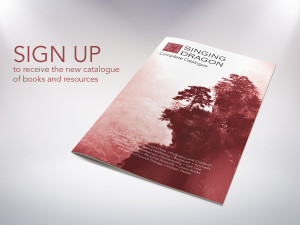 The Singing Dragon Complete Catalogue is now available. With full information on our expanding list of books in Chinese Medicine and Acupuncture, Qigong, Yoga, Aromatherapy, and a variety of other disciplines, our catalogue is an essential resource for complementary health practitioners and anyone interested in enhancing their own health, wellbeing and personal development.
The Singing Dragon Complete Catalogue is now available. With full information on our expanding list of books in Chinese Medicine and Acupuncture, Qigong, Yoga, Aromatherapy, and a variety of other disciplines, our catalogue is an essential resource for complementary health practitioners and anyone interested in enhancing their own health, wellbeing and personal development.
To receive a free copy of the catalogue, please fill out the form below and press subscribe:
Developing internal energy for enhancing your healing practice
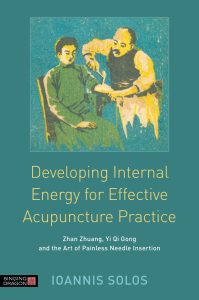 It is a common theory in all the Chinese internal styles that the qi of the dantian must reach the tips of the fingers, although, how this is accomplished may differ majorly among different arts. The purpose is to make the strikes felt deep within the opponent’s body without damaging your hands. The training of such a skill, besides the internal cultivation practices, usually involves some form of punching or hitting to strengthen the ligaments of the hands, and also to make the hits (and touch) soft, powerful and precise, able to reach deep inside.
It is a common theory in all the Chinese internal styles that the qi of the dantian must reach the tips of the fingers, although, how this is accomplished may differ majorly among different arts. The purpose is to make the strikes felt deep within the opponent’s body without damaging your hands. The training of such a skill, besides the internal cultivation practices, usually involves some form of punching or hitting to strengthen the ligaments of the hands, and also to make the hits (and touch) soft, powerful and precise, able to reach deep inside.
Crossing over to healing, such a skill is also very important, because in your tuina you need to protect the health of your hands from harm, and in acupuncture also ensure that you have the correct kind of energy that reaches deep inside the patient’s body to activate the points and channels.
The best tuina manuals usually offer some Neigong exercises designed to cultivate the right skill. Most of them include rigorous meditation while the hands work on a sand bag or a variety of other equipment. However, even such important skills become quite rare these days, because it may take some time to acquire them.
But let’s see some old exercises:
Exercise example 1: A traditional old Beijing Tuina method for teaching the hand method for the character for grasping (拿) was as follows:
“A small bucket of water was immersed inside a bigger bucket of water. The handle of the smaller bucket was attached through a leather cord to the outstretched hand of the practitioner, palm facing down. During this exercise the student had to sink the Qi to the Dantian, and then by using the round force (浑圆劲) of the whole body pull the bucket out of the water and then insert it back into the bigger bucket, without any spillage. After achieving the comfort force and the ability to assume a balanced and energy conserving posture, they would have to start meditating upon the character for grasping (拿) for the hands and rise and sink (沉-浮) for the body. Most of this exercise is happening first mentally and then physically. Movement should be soft and focused.”
Exercise example 2: This is an exercise used for the method of hitting (打) the back of the patient by using a split bamboo stick. For this skill, if the amount and type of force is not correct, it can result to damaging the muscles, skin and ligaments of the patient. An old Beijing exercise for this was as follows:
“The doctor assumes the Hun Yuan position, holding a split bamboo stick, or a Taiji long ruler, or just merely visualizing holding one. The Qi sinks to the Dan Tian, and the doctor relaxes every part of his body, until achieving a feeling of being suspended up from strings attached to the body, much like a puppet. The doctor should visualize being inside a Great Balloon that has its center in the Dantian. The outer walls of this “Great Balloon” have many hooks and barbed wire, which prevents it from moving towards any direction. The doctor however, should try to mentally move it by using his intention (意) but not any physical force, while working out all the related energetic contradictory forces (矛盾力) within his body frame. While moving the sphere with the power of the Dantian, the stick always follows the movement of the whole body, but never leads or dictates the direction. At the point (点) where the movement of the whole body stops and changes direction, the doctor should be meditating on developing the correct snapping force that is needed in hitting the back of the patient with the split bamboo stick. Most of this exercise is happening mentally, rather than physically. Movement should be soft and slight.”
In a similar way, internal cultivation for acupuncture needling should have a specific healing purpose, direct effect and an exact training methodology, based on appropriate understanding and application of Chinese energetic theories and correct body mechanics. This training should be primarily and directly applied towards treatment, exclusively in the clinic, as an unambiguous and solid therapeutic skill, where rational theory can be coupled with reasonable and consistent benefits, for both the healer and the patient.
In my latest book, Developing Internal Energy for Effective Acupuncture Practice I have included a complete training regime for assisting the energy aware practitioners to enhance their needling skills and transform their medicine into an extraordinary experience. With time and effort, perhaps one can discover the fine subtleties of the system at the energetic level.
Disclaimer: This article provides only simplified instruction for the above exercises, and purely for the sake of theoretical discussion. You should not attempt any of these without professional guidance from a certified teacher. The author of this article and the owner of this blog are not responsible for any harm that may be inflicted through the erroneous application of the information provided in this article.
~~~
Ioannis Solos studied Traditional Chinese Medicine at Middlesex University and the Beijing University of Chinese Medicine. He enjoys researching, teaching, practicing and critically interpreting the ancient philosophy and culture of China, internal martial arts, health preservation practices, classic medical texts and lesser-known Chinese esoteric traditions.
The Complexity of Chinese Astrology
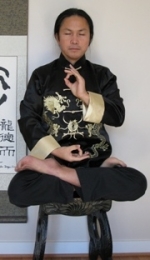 Since 1988, Master Zhongxian Wu has instructed thousands of students, both Eastern and Western. He synthesizes wisdom and experience for beginning and advancing practitioners, as well as for patients seeking healing, in his unique and professionally-designed courses and workshops.
Since 1988, Master Zhongxian Wu has instructed thousands of students, both Eastern and Western. He synthesizes wisdom and experience for beginning and advancing practitioners, as well as for patients seeking healing, in his unique and professionally-designed courses and workshops.
Master Wu is the author of several Singing Dragon books including, The 12 Chinese Animals: Create Harmony in your Daily Life through Ancient Chinese Wisdom. Here, he answers a few questions about the book.
How did this book come about?
I grew up in a traditional fishing village in southeast China, and for my entire upbringing, I saw that people commonly used astrology to help make decisions about important events (finding a spouse, setting a wedding date, building a house, opening a business, health issues, etc). Because our village had no electricity, pipe water, or roads larger than a foot path, we all lived very closely with the rhythms of nature.
Chinese astrology is the art of living in harmony with the hourly, daily, monthly, and yearly cycles of life. When I was young, my mother always consulted the people living in the local temple when she needed help. I was astonished by the accuracy of their advice and their ability to predict outcomes. I became interested in learning more about astrology and its connection to Chinese medicine and the Yijing prediction system. My main focus is teaching Qigong, Taiji and the Yijing to help others to create harmony in their life. Through over 20 years of teaching these ancient Chinese wisdom practices, I realised that Chinese astrology is a great tool to help guide people through their life and their inner cultivation.
Chinese astrology is far more complex than most people realise. What accounts for this misconception, and how does your book contribute to a deeper understanding?
In the West, most people think Chinese astrology is only about their yearly animal sign. The knowledge of Chinese astrology system is extremely complicated, and I think perhaps difficult for most people to understand. In China, we call astrology BaZi (8 characters) or MingLi (principle of your karma), but only a small amount of people actually understand how to put together and interpret a chart. Most Chinese have to find an expert to help them, and finding someone really qualified and skillful can be challenging. Of course, you may easily find a fortuneteller on the street, but they are usually not very accurate.
I think the misconception in the West is mostly for convenience sake, to make it more simplified, more available for the general public and more for entertainment value. The yearly animal sign is a small percentage of what influences your entire chart. In my book, I also discuss the monthly and daily animal sign, which will help people develop a fuller understanding of their chart. It is important to realise that the 12 animals is just one aspect of Chinese astrology – creating and understanding a whole chart for the sake of prediction is a much more complicated process.
Most people do not realise that the 12 animals also relate to the 12 tidal hexagrams of the Yijing. The Yijing, of course, is a method of understanding the rhythms of nature and of life. When I wrote this book, I wanted people to get a little taste for the complexity behind the Chinese astrological system.
What does it mean to have an energetic month, day or year?
The energetic day, month and year are based on the rhythm of the sun and moon, which is different from the Gregorian calendar. For example, the energetic year is not from January 1 (the Gregorian new year) or the first new moon of the first lunar month (the Chinese new year), but rather, it the begins at the time where the sun is exactly at the celestial longitude of 315 degrees, which usually occurs on Feb 4th or 5th in the Gregorian calendar.
How does understanding one’s Chinese animal symbols help them make better choices?
The use of Chinese animal symbols is a key to understanding the principles of your life and of your karma. They can help you understand your strengths and your weaknesses. Becoming conscious of your own patterns will give you information about how to cultivate your gifts and refine your challenges, which will help make your life flow more easily, with less struggle, and bring you success in your pursuits.
In the final chapter of the book, you discuss the Daoist concept that ‘life is not controlled by fate or karma alone’. What does this mean in the context of astrology?
If you want to change your karma, you have to know what your karma is.
A good understanding of Chinese astrology doesn’t only help you understand your karma and predict the future. The purpose of the reading is to guide you to make changes in your life, from daily lifestyle habits to larger life decisions that will allow you to change your karma, to help you remain centered when something unexpected happens, to steer clear of trauma, and put you on on the path of health, prosperity, and longevity.
How do you integrate your Chinese animal symbols into your own daily life?
I use the practices to guide my inner cultivation in order to balance and strengthen my astrological chart (which varies depending on the hour, day, month, season, year, or external life event), so that I feel more harmonious with my self, my family, and with nature. For example, I will check the Chinese calendar to pick out dates for travel or signing a contract. Based on the animal symbols, I also chose special colours for home and office in order to create the right fengshui for those environments. My wife and I make meals according the the principles of the Chinese animal clock to create a healthy daily rhythm for our family.
The 12 Chinese Animals: Create Harmony in your Daily Life through Ancient Chinese Wisdom and Master Wu’s other books on Qigong and ancient wisdom traditions are available from intl.singingdragon.com

